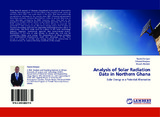| dc.contributor.author | Danyou, Yiporo | |
| dc.contributor.author | Ampaw, Edward | |
| dc.contributor.author | Musa, Abdulai | |
| dc.date.accessioned | 2015-08-14T14:21:16Z | |
| dc.date.available | 2015-08-14T14:21:16Z | |
| dc.date.issued | 2012 | |
| dc.identifier.isbn | 978-3-659-00077-5 | |
| dc.identifier.uri | http://repository.aust.edu.ng/xmlui/handle/123456789/282 | |
| dc.identifier.uri | http://library.aust.edu.ng:8080/xmlui/handle/123456789/282 | |
| dc.description.abstract | Energy plays a significant role in life. Humans need energy to operate in industries, agriculture, transport and services. Due to increasing population and technological development, humans consume more energy than before, resulting in higher air
pollution, damming of rivers, creation of nuclear waste, and other environmental drawbacks. Almost all energy used today is non-renewable which takes a long time to reproduce.
Solar energy therefore originates from the nuclear reaction within the sun’s hot core (i.e. about 6×106K), and is transmitted to the sun’s surface by radiation and hydrogen convection (Roger et al., 2003). Solar energy is the radiant light and heat from the
sun that has been harnessed by humans since ancient times using a range of ever-evolving technologies. Solar energy contributes 99.98% of all the energy that drives processes on Earth (Dorothy, 1998). | en_US |
| dc.description.sponsorship | Sponsored. | en_US |
| dc.language.iso | en | en_US |
| dc.publisher | LAP Lambert Academic | en_US |
| dc.subject | Analysis of Solar Radiation Data in Northern Ghana | en_US |
| dc.subject | Solar Energy as a Potential Alternative | en_US |
| dc.title | Analysis of Solar Radiation Data in Northern Ghana | en_US |
| dc.title.alternative | Solar Energy as a Potential Alternative | en_US |
| dc.type | Book | en_US |

